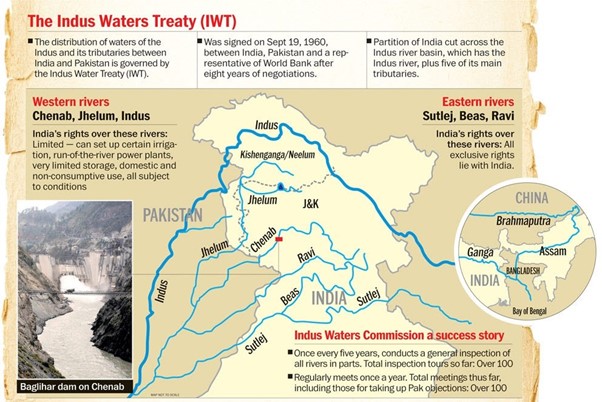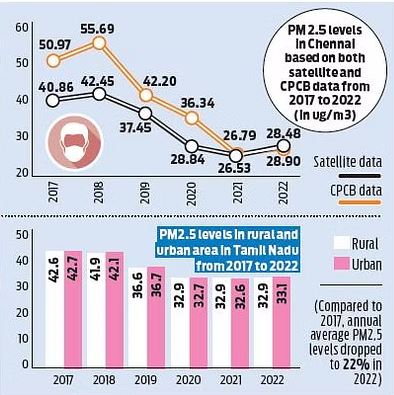Groundwater Springs of Norway
As global warming drives glaciers to retreat, methane-rich groundwater springs are punching through the surface in the Arctic.
- Groundwater Springs - A spring is a natural opening in the ground where water flows directly from the aquifer to the earth's surface.
Groundwater springs of Norway
- Methane is a potent greenhouse gas.
- High methane concentrations near shale rocks moves upwards through fractures in the rocks and gathers under the glacier.
- A lot more methane gas is trapped under glaciers, waiting to escape.
- Shrinking Arctic glaciers are uncovering bubbling groundwater springs.
- These springs release large amounts of methane trapped under glaciers.
- Europe and Canada spotted groundwater springs exposed by 78 retreating glaciers in Svalbard.
- Svalbard - A Norwegian archipelago in the Arctic which is warming faster than the rest of the Arctic.
- In Svalbard groundwater springs could be emitting more than 2,000 tonnes of methane annually.
- These springs are not part of the global methane budget,
The global methane budget estimates the amount of methane released through sources and captured through sinks.
Reference
Down to Earth | Groundwater springs of Norway
Sci Tech Daily | Arctic’s Melting Glaciers Reveal Methane Time Bomb
Indus dispute & Permanent Court of Arbitration
Recently, India said that it will not join the Pakistan-initiated proceedings at the Permanent Court of Arbitration as the dispute is being already examined under the Indus Waters Treaty.
- Indus Waters Treaty - The Indus Waters Treaty was signed in 1960 between India and Pakistan.
- It was brokered by the World Bank.
- The World Bank is also a signatory to the Indus Water Treaty.
- The treaty administers how river Indus and its tributaries that flow in both the countries will be utilised.
- Rights of water usage - The treaty divides the Indus system into two segments:
- Eastern Rivers - Sutlej, Beas and Ravi
- Western Rivers - Indus, Chenab and Jhelum
- India gets right of unrestricted use over the Eastern rivers while Pakistan is entitled to unrestricted use of the Western rivers.
- India is under obligation to let flow the western rivers unrestricted.
- However, since Indus flows from India, the country is allowed to use 20% of its water for irrigation, power generation and transport purposes.
- Both India and Pakistan have the right to non-consumptive use and rights of drainage issues and river conservation aspects.
- Dispute resolution - A Permanent Indus Commission was set up as a bilateral commission to
- Implement and manage the Treaty
- Solve disputes arising over water sharing
- Article 8 of the treaty, both sides are expected to meet at least once a year to discuss bilateral problems.
- After the Uri terror attack in 2016, India had suspended routine bi-annual talks between the Indus Commissioners of the two countries.
- Withdrawal from the treaty - Experts suggest that India can exercise the sovereign right of a state under Article 64 of the Vienna Convention to withdraw from any international treaty.

Article XII (3) of the treaty says that the provisions of this treaty may from time to time be modified by a duly ratified treaty concluded for that purpose between the two Governments.
Recent happenings
- Parallel adjudication - Pakistan had approached the World Bank to constitute a Court of Arbitration whereas India sought for the appointment of a Neutral Expert for dispute redressal.
- In January the meeting of the neutral expert took place at The Hague regarding Indus river water dispute.
- India considers the start of the 2 concurrent processes to resolve the dispute violates the provision of the three-step graded mechanism prescribed in the pact.
- India said that it cannot be compelled to recognise or participate in illegal and parallel proceedings not envisaged by the treaty.
Permanent Court of Arbitration
- It was established by treaty in 1899.
- It is an intergovernmental organization providing a variety of dispute resolution services to the international community.
- There are 225 arbitrators, appointed for a 6-year term.
- Headquarters - The Hague.
- The President of the Council is the foreign minister of the Netherlands.
- India and Pakistan are members of the Permanent Court of Arbitration.
Reference
The Hindu | India rejects ruling by Permanent Court of Arbitration
Permanent Court of Arbitration | Contracting Parties
India-Russia Oil Trade
Indian refiners saved at least $7.17 billion in foreign exchange by ramping up purchases of discounted Russian crude oil following the outbreak of the war in Ukraine.
- India, the world’s 3rd largest consumer of crude oil, depends on imports to meet over 85% of its oil needs.
- Russia in the wake of its invasion of Ukraine, Western buyers are cutting oil imports from Moscow.
- Thus it has been offering discounts on its crude and Indian refiners have been lapping up these discounted barrels.
- Russia, which used to be a marginal player in India’s oil trade, is now India’s biggest oil supplier.
- The value of oil imports from Russia for the period from April 2022 to May 2023 was nearly $40 billion.
- The average landed price of Russian crude for Indian refiners for the 14-month period had an effective discount of 15.3% to the average price of oil imported from other supplying nations.
- The savings are substantial considering these were accrued by 5 Indian refining majors
- Indian Oil Corporation,
- Reliance Industries,
- Bharat Petroleum Corporation,
- Hindustan Petroleum Corporation, and
- Nayara Energy - and their arms.
Other Countries that supply crude to India

Reference
The Indian Express | Discounted Russian crude imports saved India
Himalayan RFSLAPs
A recent study suggests that air pollution which decreased in India during the COVID-19 pandemic, slowed the melting of snow in the Himalayas.
Light-absorbing particles (LAPs)
- Light-absorbing particles (LAPs) such as black carbon or mineral dust are some of the main drivers of snow radiative transfer.
- Small amounts of LAPs significantly increase snowpack absorption in the visible wavelengths where ice absorption is particularly weak, impacting the surface energy budget of snow-covered areas.
Recent Findings
An average aerosol optical depth according to the National Oceanic and Atmospheric Administration (NOAA) in U.S. is 0.1 to 0.15.
- A decrease in air pollution in India during the COVID-19 pandemic slowed the melting of snow in the Himalayas.
- Aerosol optical depth values dropped sharply and air quality improved across the country.
- The deposition of light-absorbing particles (LAPs) and the resulting positive radiative forcing on snow (RFSLAPs) substantially contributes to glacier retreat.
- Lockdown-induced human emission reduction to the RFSLAPs decrease in the western, central, and eastern Himalayas were 46.8%, 81.1%, and 110.5%, respectively.
- The reduced RFSLAPs might have led to 27 Mt reduction in ice and snow melt over the Himalaya in 2020.
- LAP concentrations over the Indus Basin have also decreased greatly.
- Such a reduction in LAPs over India might have meant a substantial drop in pollution transported to the Tibetan Plateau.
- Mineral dust transported from the Thar Desert by westerly winds deeply influences RFSLAPs and the rate of ice and snow melting in the western and central Himalayas.
At the current pace of warming, up to 70% of Himalayan glaciers could be lost this century.
Reference
Down to Earth | Drop in air pollution in India during 2020
Researchgate | Impacts of transboundary pollution across the Himalayas
National Clean Air Programme
A recent study says that there has been a dip in the concentration levels of particulate matter (PM2.5) in both in rural and urban areas, where the National Clean Air Programme (NCAP) is being implemented.
- National Clean Air Programme (NCAP) is a national-level strategy for reducing the levels of air pollution at both the regional and urban scales.
- Target is for reduction of 20-30% of PM2.5 and PM10 concentration by 2024.
Objectives
- To ensure stringent implementation of mitigation measures for prevention, control and abatement of air pollution.
- To augment and evolve effective and proficient ambient air quality monitoring network across the country for ensuring a comprehensive and reliable database
- To augment public awareness and capacity-building measures encompassing data dissemination and public outreach programmes for inclusive public participation and for ensuring trained manpower and infrastructure on air pollution.
According to CPCB’s national ambient air quality standards (NAAQS), the annual average safe limit for PM 2.5 is 40 ug/m3 and for PM10 it is 60 ug/m3.
Recent Findings
- There has been a considerable dip in the concentration levels of PM2.5 in Tamil Nadu, both in rural & urban areas, where the National Clean Air Programme (NCAP) is being implemented.
- The study titled ‘Status of urban and rural air quality exposure at national scare: A comparative analysis’ was conducted to assess the overall air quality improvement in all the states and major metropolitan cities.
- The study assessed the cities using satellite data available with IIT Delhi and CPCB from 2017-2022.
- It shows 22% drop in PM2.5 levels in Tamil Nadu compared to 2017 which is from 32.9µg/m3 to 29µg/m3.
- One of the key highlights of the study is that the air pollution levels were uniform in both rural and urban settings, which shows that PMs doesn’t have boundaries.
- By the end of 2022, each state should have at least 20-25% annual average PM2.5 reduction levels on the conservative side and a 30-35% reduction on the positive higher side.

Reference
New Indian Express | Pollution dips by 22 per cent in 5 years in TN

